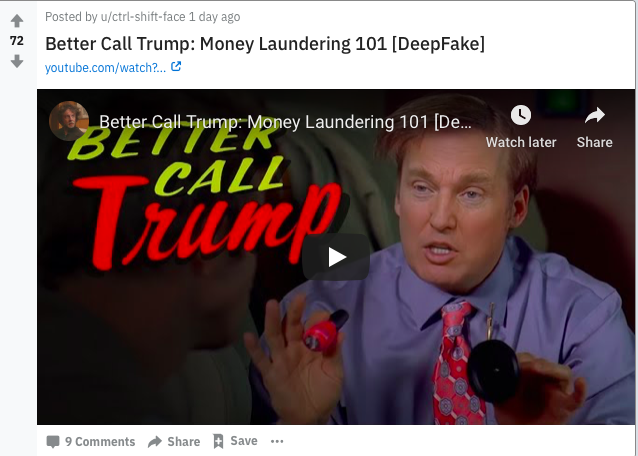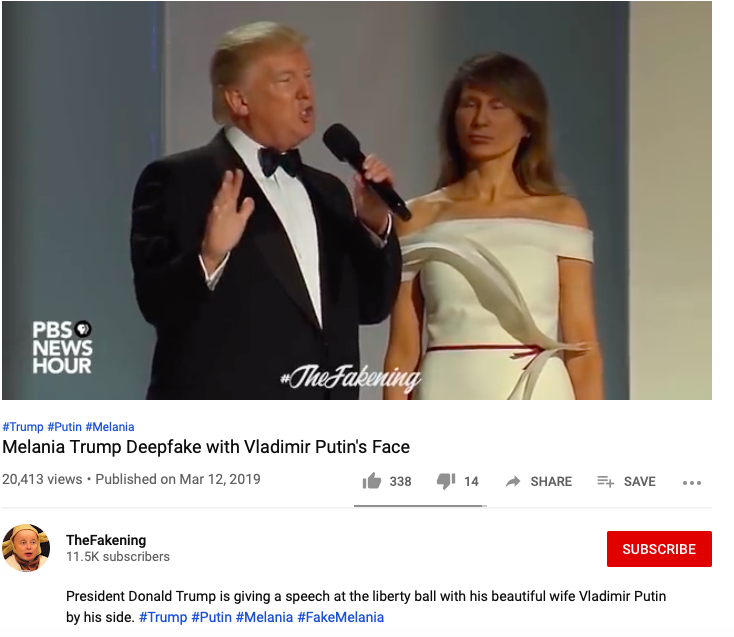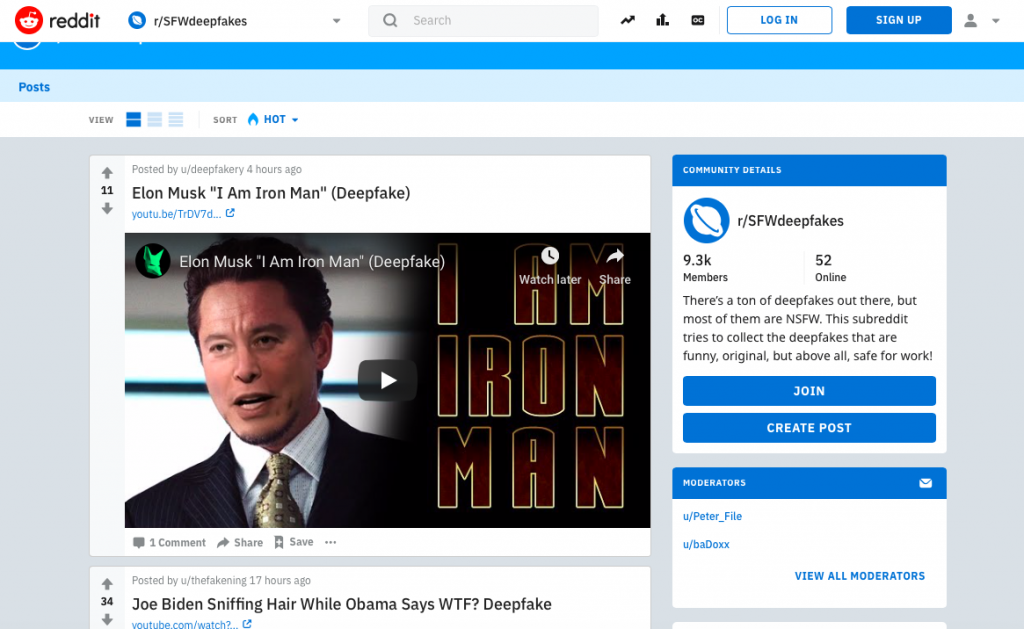Deepfake technology: a paradox of economic and political possibilities
Abstract:
Nowadays, deepfake technology seems to be a trending debate in not only media academia but also the social world. The discussions encompass many economic and political concerns that perhaps become prerequisites of further research in disinformation, misinformation and malinformation. However, more controversies rise with the rapid development of deepfake technology. Today, let’s brainstorm the paradox in this emerging cybernetic world.

There is nothing more exciting than your own face appearing in one of favorite movies, as a Chinese app ZAO allows every end-user to become movie stars through uploading a photo of themselves. In the west, similar technologies of face-swapping videos have been also used in poking fun of politicians and celebrities and in entertaining video clips, on platforms such as Reddit, Youtube and 9GAG. For example, a short film entitled as “Better Call Trump: Money Laundering 101” unveils Trump’s “greedy” conversation with a young man(Reddit.com). Also, Melania Trump was trolled with Vladimir Putin’s face in a speech of Trump(youtube.com). On Reddit, Elon Musk replaced Robert Downey in the movie clip of Iron man. These objects are artificially crafted by an emerging technology “deepfake”, which is a paradoxical image recognition software induced in the hyper and multi-mediated world. Sometimes it can act as a virus, when formal ways get casual and when authenticity turns to be fake. This opens up socio-political skepticisms in both academia and work fields. Even Facebook decides to invest $10 millionIn combatting future wave(s) of seamless fake videos(ai.facebook.com). It made me wonder why the giant IT company is willing to pay “a fortune” to find detecting resolution of this technology. How “powerful” is “deepfake”?

Source: Reddit.com

Source: Reddit.com

Source: Youtube.com
The birth of “deepfake”
The term is invented by an anonymous Reddit user who initially named himself as “deepfake” in December 2017. He firstly produced pornographic content of face-swapping of female movie stars. They went viral before being spread from Reddit to other content-shared sites across the internet(Fletch 461). Although he ultimately got banned from Reddit, a wave of copycats emerged on other platforms. The user shared the code used to create the face-swapping algorithms, which encouraged the follow-up online copycats and variations in more micro-economy of content sharing that are not porns. In fact, the face-swapping technology has a long history in big-budget movies, but the quality could not match the CGI and motion-capture’s expenses. Thanks to artificial intelligence, the complex game that swapping faces with a seamless mask of another person become affordable and accessible (463). Things become even easier when January 2018 FakeApp penetrated the market. The desk app gives opportunities to users who lack coding and programming skills. We can simply upload two video clips and wait for the laptop to progress passable swaps(463). The technology does not only enjoy the victory of image recognition effects but also seeks a way to audiovisual files that perfectly match the voice of the subject.
A paradox of political and economic possibilities
Imaging politicians are being “captured” in deepfake scandals, a threat will be posed towards the democratic public sphere and legal controversies. As we all know, digital platforms are using algorithms to collect user data while analyzing and predicting the clustered traits of them. Consequently, these engines create “a unique universe of information for each of us”(Pariser 8) and entrench us in our own echo chamber. Eli Pariser calls this as “filter bubble”(8). On Google or Facebook, our past clicking behavior is transformed to be predictable datasets which are used to influence the way we understand the world and interactions. Together with Cambridge Analytica’s type of practices, fake news about US politicians and Brexit shaped our political perceptions and decision-making processes. It is hard to tell whether Cambridge Analytica’s copycats would not intervene in future political events, especially when deepfake plays a big role in it.
Similarly, the deepfake technology provides a room for illegal behaviors and masked terrorists’ acts. For example, criminals can cover their behavior with the faces of scapegoats. It might be an obstacle in lawsuit cases. According to Maras and Alexandrou, in some states of the US, “the courts ruled that an image or video were admissible as long as the reliability of the digital evidence could be verified.” (258) It is scary when deepfake fills the gap in artificial discrepancies and its pieces become as reliable as the authentic videos. Punishing a convict gets tricky for jury who can only rely on the evidence in the US.
Moreover, video with deepfake content may involve copy right’s risks and privacy issues. Chinese company MoMo, who published ZAO a Chinese version of deepfake App, was accused for avoiding responsibility of protecting user privacy after going viral(theguardian.com). The platform’s unrefined term and condition causes public concerns in personal portrait right, information disclosure and data transaction by third-party applications. Most importantly, if the app is published without pressure, other beauty camera apps will lose their market. A follow-up issue regarding business monopoly will rise.
As Marshall McLuhan said: “medium shapes and controls the scale and form of human association and action”(9). Deepfake may amplify polarizations of political preferences, competitions and dis and mis information in the social cascades of both offline and online communications. Fake news and rumors provide no good but harm, and Deepfake enhances the consequences. Insecurity and untrustworthiness become common in the public opinion. Statistics in 2016 show a continuous decline of “trust and confidence” in mass media when “it comes to reporting the news fully, accurately, and fairly” after the American election (Allcot and Gentzkow 215). When Deepfake videos take over online genuine content, how many people will still trust the daily news we see ubiquitously? If we are no longer believing in the news, what else can we use to acknowledge the world? or are we going to slowdown and go back to traditional mediums?
Altogether these questions draw an open conclusion: deepfake should be double-edged (actually more danger than fun). In particular, the technology blurs the boundary between the genuine and the ingenuine. With the distributed logic of network, its content are circulated in multi-mediated platforms on which everyone’s data is transmittable currency. The matrix becomes a paradox of possibilities that brings discussions on surveillance, datafication, democratic concerns and news trustworthiness. Scholars may have further research in how deepfake is embedded in platform capitalism and might also question the future solution to online perception and wisdom of truth.
Reference:
Allcott, Hunt, and Gentzkow, Matthew. “Social Media and Fake News in the 2016 Election.” Journal of Economic Perspectives, vol. 31, no. 2, American Economic Association, May 2017, pp. 211–36, doi:10.1257/jep.31.2.211.
“Chinese Deepfake App Zao Sparks Privacy Row After Going Viral”. The Guardian, 2019, https://www.theguardian.com/technology/2019/sep/02/chinese-face-swap-app-zao-triggers-privacy-fears-viral.
“Creating A Data Set And A Challenge For Deepfakes”. Ai.Facebook.Com, 2019, https://ai.facebook.com/blog/deepfake-detection-challenge/.
“Deepfakes That Are Safe For Work”. Reddit.Com, 2019, https://www.reddit.com/r/SFWdeepfakes/.
Fletcher, John. “Deepfakes, Artificial Intelligence, and Some Kind of Dystopia: The New Faces of Online Post-Fact Performance.” Theatre Journal, vol. 70, no. 4, Johns Hopkins University Press, Dec. 2018, pp. 455–71, doi:10.1353/tj.2018.0097.
MacLuhan, Marshall. Understanding Media : the Extensions of Man. Routledge, 2001.
Maras, Marie-Helen, and Alexandrou, Alex. “Determining Authenticity of Video Evidence in the Age of Artificial Intelligence and in the Wake of Deepfake Videos.” The International Journal of Evidence & Proof, vol. 23, no. 3, SAGE Publications, July 2019, pp. 255–62, doi:10.1177/1365712718807226.
“Melania Trump Deepfake With Vladimir Putin’s Face”. Youtube, 2019, https://www.youtube.com/watch?v=K3kgBStHFHs.
Pariser, Eli. The Filter Bubble : What the Internet Is Hiding from You . Penguin Books, 2012.